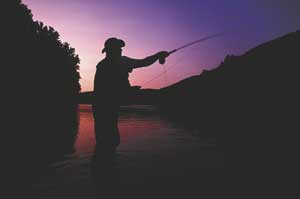
Maybe you consider wading through ice-cold mountain streams in January a euphemism for acute hyperthermia. You might also think casting for redfish on some windy inshore flat in winter is a precursor for walking pneumonia. Fishing, of any variety, in the dead of winter is certainly not for everyone.And for those of us who enjoy winter as possibly our only opportunity to fish our favorite honey holes in solitude, this is a positive thing.
If you’re not inclined to take advantage of some of South Carolina’s superb winter trout or coastal flats fishing opportunities, this could be the time of year to practice, refine or improve your fly-casting stroke.
This can be done from the relative comfort of your own backyard. Warmth and hot coffee are only a few dozen steps from your practice area.
Here are some fly casting basics to remember when honing your casting stroke during the weather months:
• It’s important to remember that in order to cast efficiently during forward and back casts, any slack must be removed from the line prior to the start of the cast.
Simply put, the line must be taut before the cast ever begins. This is true for the forward and the back cast. You’ll not move the line or load the rod until the slack is gone. Power and efficiency will be wasted if the arm moves without the line.
• During the back and forward casts, the casting stroke must be accelerated to a hard stop. Your casting motion must continually gain speed until the rod is brought to a complete stop in the desired position.
By accelerating, the rod is kept loaded at all times. A constant speed either forward or back will not load the rod properly and the cast will fail.
Do not decelerate at the end of the stroke. The hard stop at the end of both the back and front cast is often compared to flicking wet paint from a paint brush. This comparison helped me greatly when I was first learning to cast.
• A longer casting stroke will result in a longer cast. Conversely, a shorter stroke will lead to a shorter cast. This is simple to understand but still requires practice.
• How your rod tip travels during the casting stroke defines how your line will travel through the air. If the rod tip travels straight, then your line will be straight; if curved, then a curved or wavy line.
The direction of your cast is defined by the direction of your rod tip at the end of the end of the casting stroke. If your rod tip is curved by the way you stop your rod or hold your rod, then your line will curve on the cast as well.
It’s during the back cast when most casting problems originate with beginning fly casters.
The old saying is: “When you’re fly casting, 80 percent of your problems are behind you” (meaning most casting problems relate to the back cast).
The perfect back cast is one that, when viewed from all angles, is 180 degrees away from the intended forward cast and has enough momentum to load the rod by bending back the rod tip. The line should be in a fairly tight loop and have no slack in it as you begin your forward cast. If your back cast is 180 degrees from your target, you will minimize tailing loops.
A tailing loop is caused by the end of the fly line running into the rest of the line on the cast (either forward or back). A back cast out of alignment or a rod tip not tracking straight can cause the problem.
Make a good back cast and keep the rod tip tracking straight on the forward cast. The tailing loop should disappear.
Keep these basic principles in mind while keeping winter rust from creeping in on your casting stroke.
Spring will be here before you realize it.



Be the first to comment